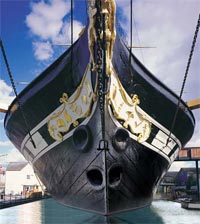 Forty years ago, on July 5th, 100,000 people lined the banks of the River Avon to witness the return of the SS Great Britain, or what was left of her. After spending 37 years on the seabed in the Falklands, she was a rusting hulk. In 1843, she was Isambard Kingdom Brunel‘s masterpiece, the world’s first iron-hulled screw-driven passenger liner. She has now been restored to her former glory. As a museum she has been toured by over 5 million people. She may be a model or at least a source inspiration for what can be done in the restoration and preservation of historic ships.
Forty years ago, on July 5th, 100,000 people lined the banks of the River Avon to witness the return of the SS Great Britain, or what was left of her. After spending 37 years on the seabed in the Falklands, she was a rusting hulk. In 1843, she was Isambard Kingdom Brunel‘s masterpiece, the world’s first iron-hulled screw-driven passenger liner. She has now been restored to her former glory. As a museum she has been toured by over 5 million people. She may be a model or at least a source inspiration for what can be done in the restoration and preservation of historic ships.
SS Great Britain: From seabed to national treasure
The SS Great Britain was the world’s first iron-hulled screw-driven ocean liner, propelled by a combination of steam and sail power and launched from Bristol in 1843.
She criss-crossed the Atlantic, made 32 runs to Australia with emigrants, served as a troop ship in the Crimean war and the Indian Mutiny, and later became a cargo ship. The ship was eventually scuttled in the Falkland Islands in 1937 after 50 years as a storage hulk. It had been a sad end for a great ship.
Then came the daring rescue mission. “She was a ship-shaped lump of iron, rust, and scrap,” said Ivor Boyce, one of the tugboat skippers who gently towed her home. He remembered telling his friends: “What are they going to do with her? No way can they make that into a viable ship anymore.”
Many others though were swept away by the romance of the story. The daring rescue 8,000 miles from home, the near impossible task of raising Isambard Kingdom Brunel’s great iron steam ship from the sea bed, the perilous journey across the Atlantic – all this stirred the hearts of Bristolians.
When reflecting on the SS Great Britain, Prince Philip also spoke of the tragedy of the clipper ship City of Adelaide.
Prince Philip reflects on revival of SS Great Britain
People had got it into their heads that we are looking after historic buildings, but it was a completely new concept that we should look after historic ships. The National Trust was there for old buildings, but there was no one there for old ships.
“We’ve still got a hideous problem with the City of Adelaide (the world’s oldest surviving clipper ship) which belongs to the Scottish Maritime Museum but it’s caught in a trap.
Because it was falling to bits they pulled her out of the water and it’s now become a listed building. But they can’t raise the money to do anything about it. You can’t seem to concentrate the interest. It’s a great pity.”

Pingback: Bristol Harbor Festival 2010 Begins Today : Old Salt Blog – a virtual port of call for all those who love the sea
Pingback: 40th Anniversary of Black Tot Day : Old Salt Blog – a virtual port of call for all those who love the sea
Pingback: Is the Restored Cutty Sark a Clucking, Grade A Turkey? | Old Salt Blog – a virtual port of call for all those who love the sea